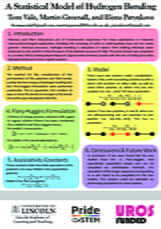by Tom Vale

Hydrogen bonding is ubiquitous in nature. It is responsible for holding the helices of DNA to one another, holding water molecules together, holding polymers together, and many other phenomena of great importance to the life and natural sciences. The motivation for the project was to model hydrogen bonds through the use of combinatoric methods using the “association model” approach.
This project, namely A statistical model of hydrogen bonding, was carried out over six weeks. The first week concentrated on background reading, where I revised combinatoric (or “counting”) methods and methods from soft matter physics; as the models I would be using to study the physics of hydrogen bonding would involve molecules forming polymers in equilibrium conditions, I also read up on polymer statics, as well as the recently published “Hydrogen bonding in acrylamide and its role in the scattering behaviour of acrylamide-based block copolymers”, as this is the paper my internal/external supervisors wrote and based the project off. In the second week, I attended a meeting at Aston University, Birmingham, with the external supervisor where Martin, Elena, and I discussed the possibilities for the project and the direction it was best to take it in. It was decided that two models would be the focus, the first model had a molecule of type A which was self-associating and a molecules of type B which could only “donate” a hydrogen bond, and the second model had [different] molecules of type A and type B, neither of which were self-associating, both of which contained two possible sites for hydrogen bonding. The third though sixth weeks of the project were spent forming the mathematical model and performing relevant calculations for each of the systems.
This research project has taught me how to form a mathematical model from first principles, and how to tell when a mathematical model is physically inaccurate. I have also learnt more about combinatorics, the physics of hydrogen bonding generally, polymer physics, particularly polymer statics, and statistical mechanics than is generally taught within the standard undergraduate physics course. The opportunity to work with Martin and Elena was greatly appreciated, as well as the conversations with the School of Mathematics and Physics throughout the project. The insights provided, and even the paper the project was based on, showed the importance of collaborative work, with the experimentalists carrying out an experiment and the theorists fitting a model to the data provided.
This experience has assured me that continuing on the path of academia is the correct thing for me going forward, showing me what a research collaboration may be like on a larger project may be like. I was also lucky to attend the 3rd Edwards Symposium, Turing Gateway to Mathematics: New Horizons in Soft Matter conference at the University of Cambridge and present my work as a part of my supervisors’ larger poster on the aforementioned paper.
*To view Tom’s project poster, please click on the thumbnail below:
